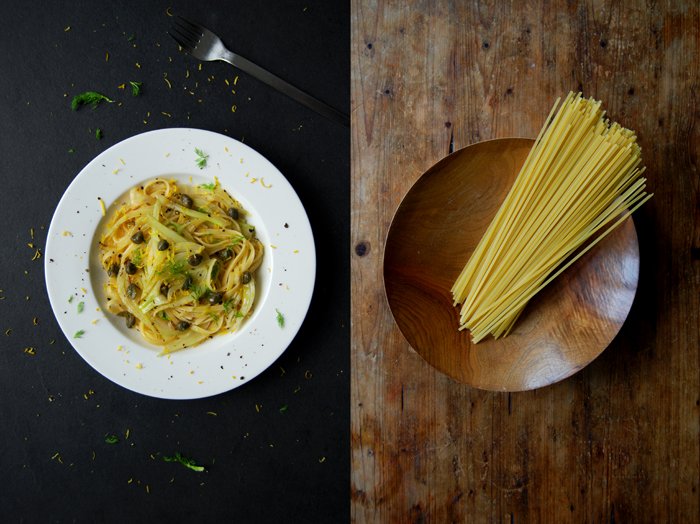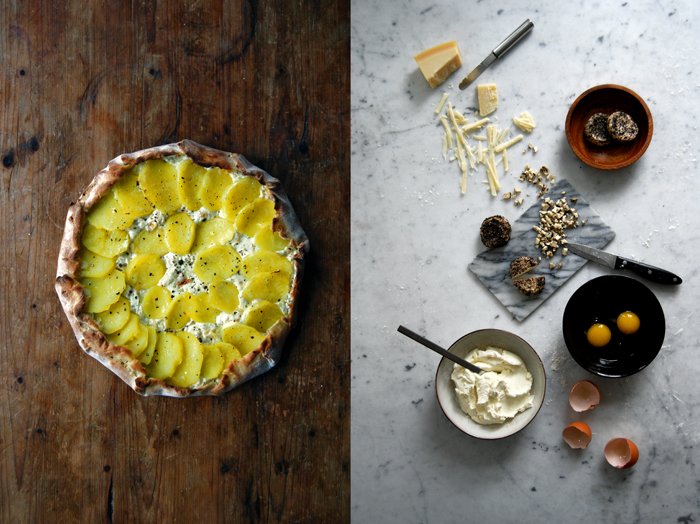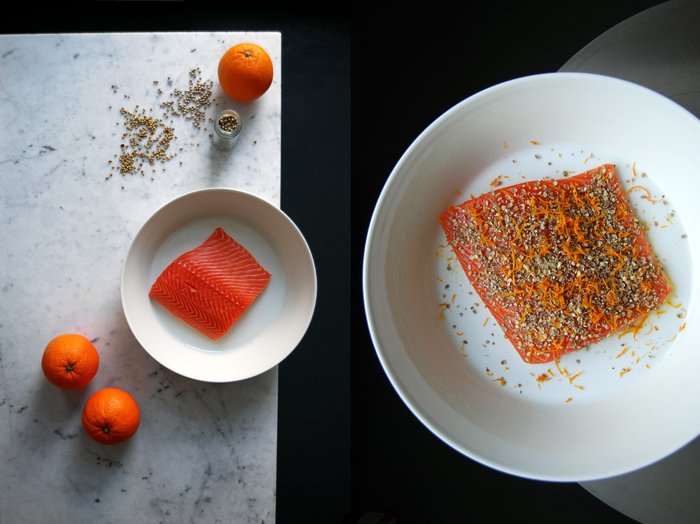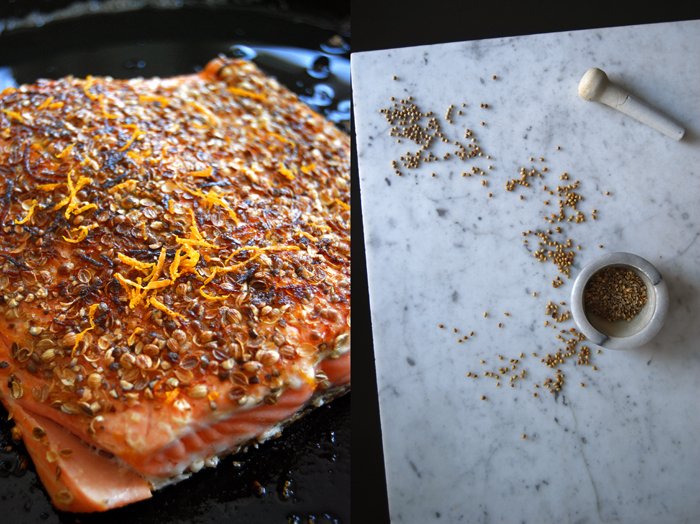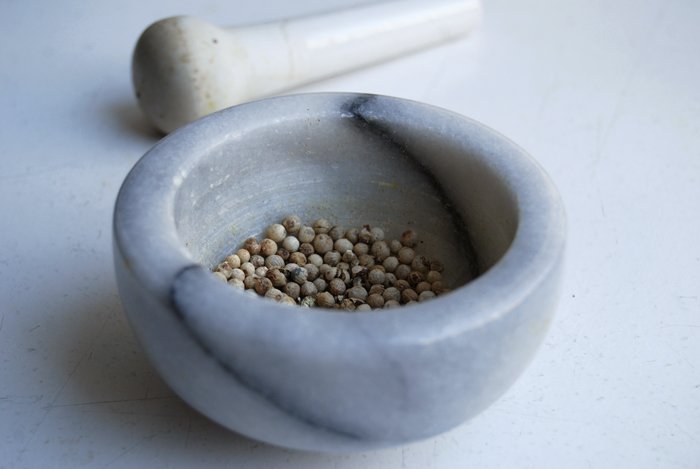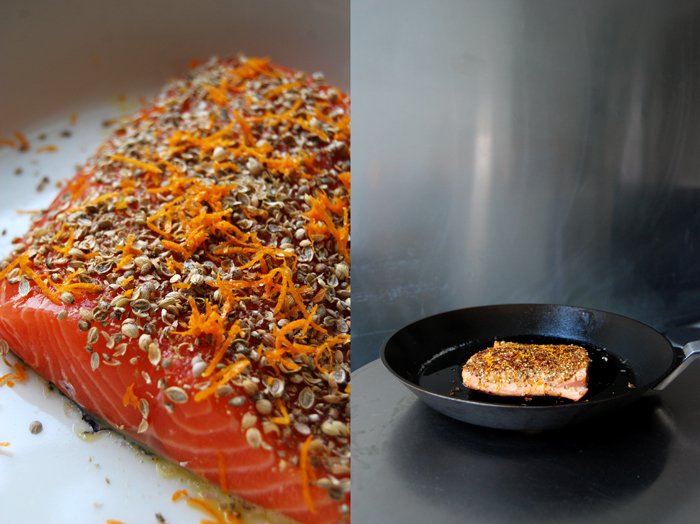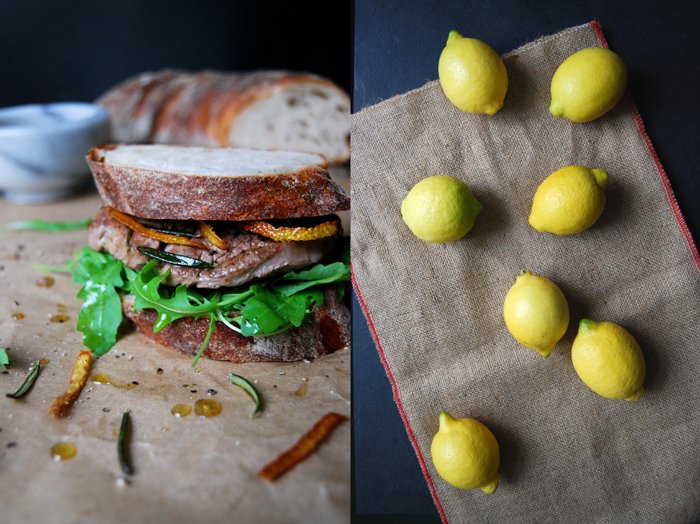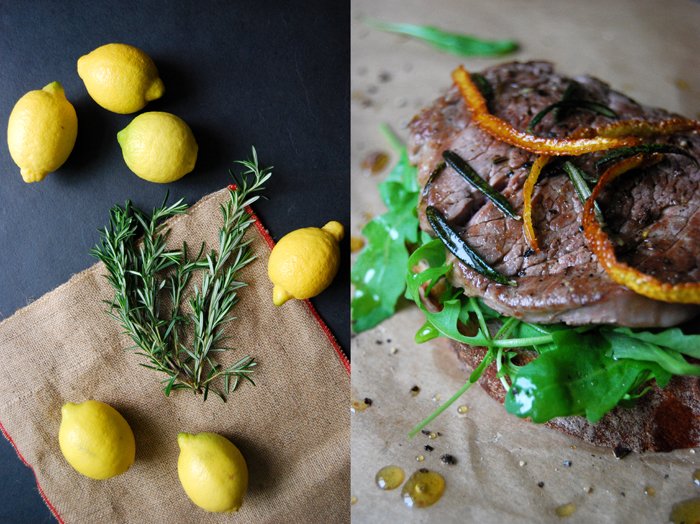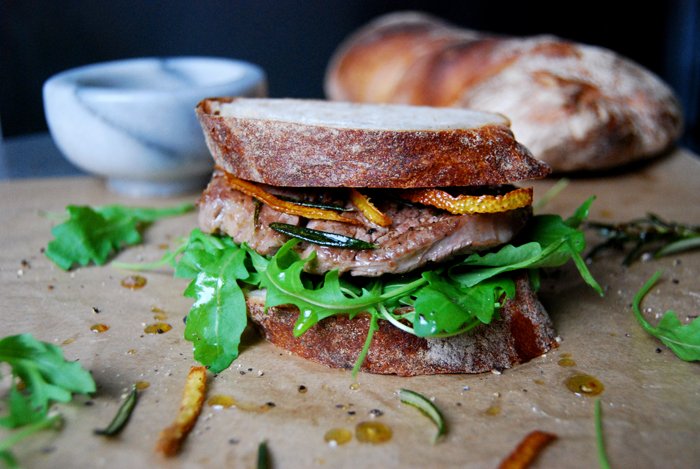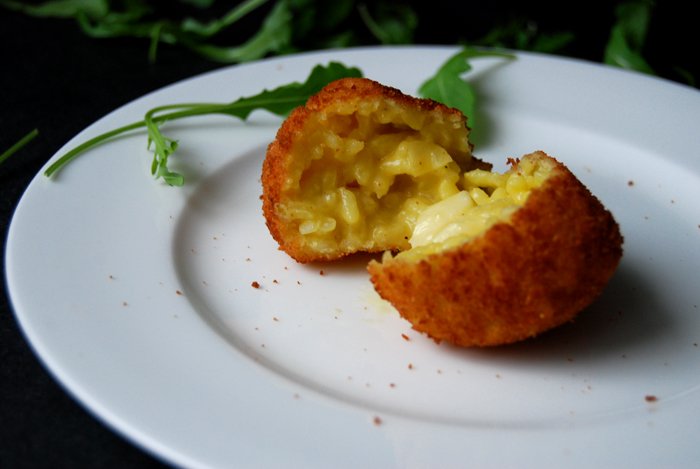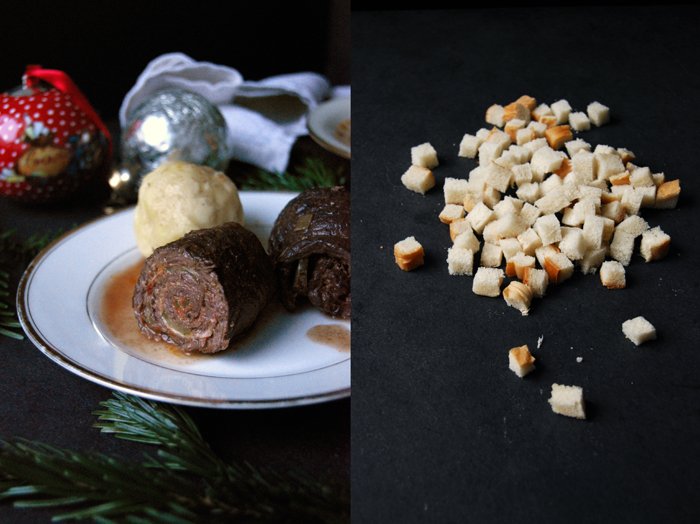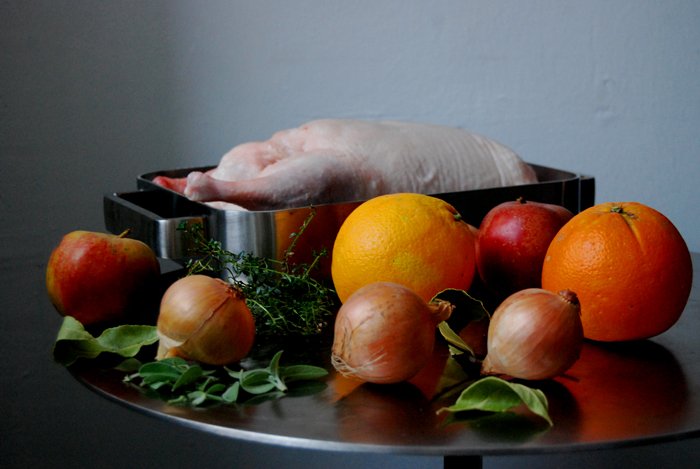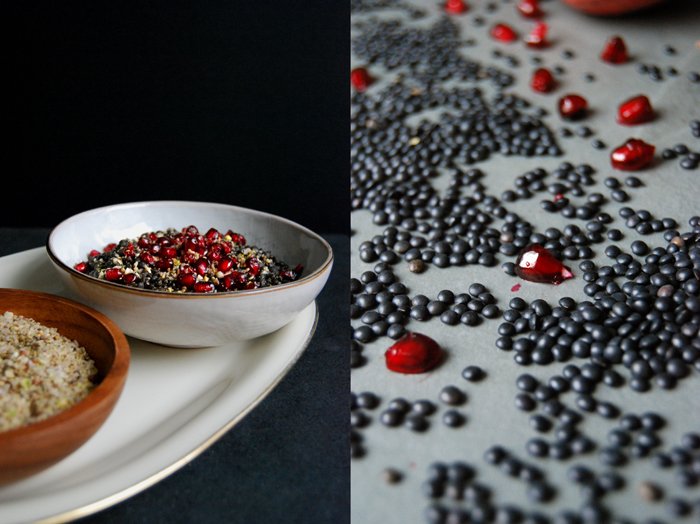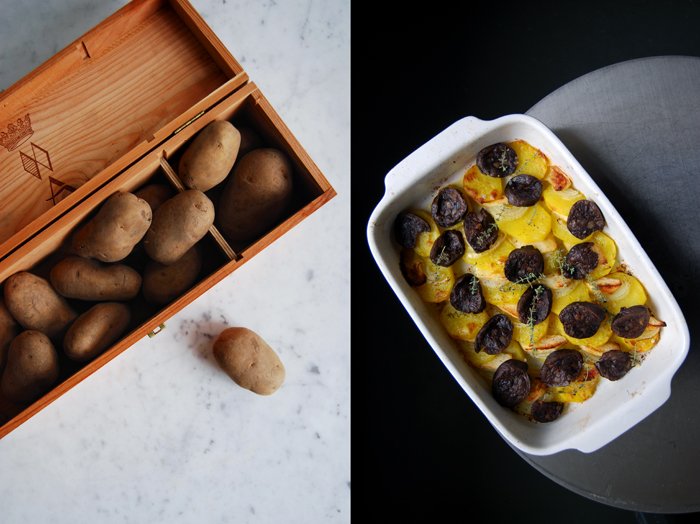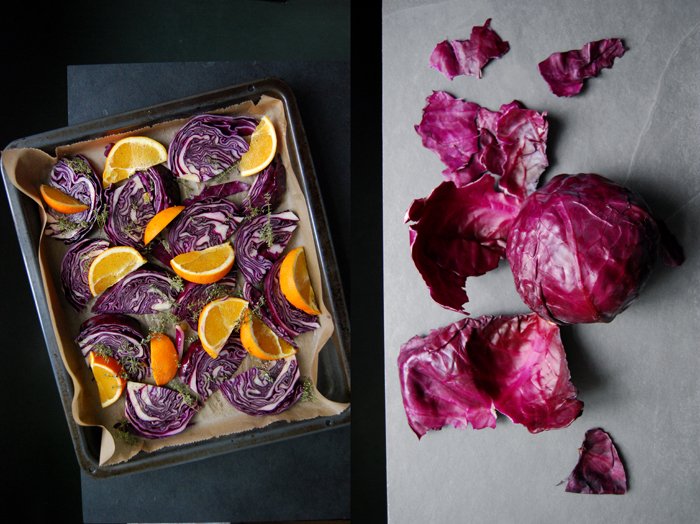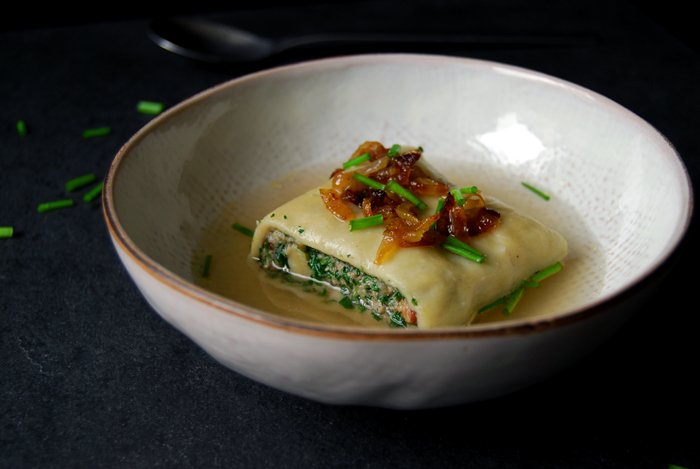Potato and Endive Gratin with Chèvre and Thyme
A gratin has the same effect on me as pizza or lasagna, I just want to cuddle up on the sofa and get cosy. This dish spreads such a beautiful aroma of baked cheese and herbs through my flat, it instantly relaxes me. Sometimes I just sit in front of the glass oven door, enjoying the scene of bubbling cream and cheese that turns from an unspectacular pale white to a landscape of golden brown peaks. They look like tiny volcanos with dark tips ready to burst. It's just a gratin but when you look at it long enough it carries you away!
I don't remember how many different potato gratin recipes I have tried out in my kitchen, there were so many. I shared the ones with dried porcini, black pudding, apples or parsnips and today there will be a new addition to the selection: Potato and endive gratin with chèvre and thyme! The combination is great, quite strong with sweet, bitter, milky and woody flavours. I wanted a quick dish, so I boiled the potatoes and sautéed the endives before I baked them with cream and milk in the oven. You could easily come up with some variations and use raclette or blue cheese instead of the chèvre, or add some slices of pears or apples, mix in some chopped rosemary or whatever comes to mind to suit your cosy dinner.
Potato and Endive Gratin with Chèvre and Thyme
For 3-4 people you need
potatoes, boiled, peeled and sliced, 700g / 1.5 pounds
Belgian endives, cut in half, 4
heavy cream 100ml / 3.5 ounces
milk 60ml / 2 ounces
freshly grated nutmeg
salt 1 teaspoon
pepper
chèvre 125g / 4.5 ounces
thyme, the leaves of a small bunch
olive oil
butter 2 teaspoons
Set the oven to 200°C / 390°F and butter a round 28cm / 11" gratin form or baking dish.
In a pan, heat a splash of olive oil and butter and sauté the endives for 2 minutes on each side on medium-high. Season with salt and pepper.
Whisk the cream and milk and season with salt, pepper and nutmeg. Arrange the potatoes and endives in the buttered dish and pour the cream and milk mixture over the vegetables. Sprinkle with chèvre and thyme and bake for 18 minutes. Turn the oven down to 160°C / 320°F and bake for another 5 minutes or until golden brown. Let the gratin cool for a few minutes before serving and season with pepper to taste.
Seared Tuna with Ginger, Lemon, Butter Beans and Onions
A tuna salad with white beans and onions is a wonderful light treat on a warm, summery evening, unfortunately, this is not exactly the kind of scene I find in wintery Europe at the moment. However, with a few minor changes, this dish can become something that can satisfy the needs of a cold day in January. Replace the canned fish with a fresh steak, add some warming ginger and crushed black peppercorns to it, and you'll see it in a different way. Instead of the small cannellini beans which are perfect for salads I went for a can of butter beans. The big, velvety legumes are rich and quite filling, a small plate is more than enough and you won't feel hungry for hours! This is why I prefer them in the cold season, for hearty dishes like my butter bean and fennel soup, although they are often featured in Mediterranean summer dishes.
The preparation didn't take any longer than the salad: I seared the firm steak for just a minute on each side as I wanted it to stay slightly pink inside, if you leave it on the heat too long it becomes dry. Some like to cook tuna for a few seconds to keep it completely raw but that's not my thing, other recipes recommend finishing it in the oven for a minute after it's been pan-seared. My piece was about 2 1/2cm / 1" thick and it was cooked to perfection. I sprinkled the tuna with freshly grated ginger and lemon zest and put it on top of the beans mixed with thin slices of red onions. The vegetables had a fruity dressing made with olive oil, freshly squeezed orange juice, white Balsamico vinegar and some of the grated root and citrus peel to pick up the aromas. It felt like a far away summer memory in a different setting which is great as long as it tastes so good!
I also don't want to miss out on telling you some great news: I'm so excited, eat in my kitchen has been featured in the German food magazine Lust auf Genuss! In the February print issue you can find an interview with me and an orange and lemon recipe I developed for the magazine with lamb chops and mashed potatoes.
Seared Tuna with Ginger, Lemon, Butter Beans and Onions
As a lunch for 2 you need
tuna steak (about 2 1/2cm / 1" thick) 200g / 7 ounces (take 2 steaks for 2 hungry people)
canned butter beans, rinsed and drained, 240g / 8 1/2 ounces
small red onion, cut in half and very thinly sliced, 1
olive oil 3 tablespoons plus more for frying
freshly squeezed orange juice 1 tablespoon
white balsamic vinegar 1 tablespoon
lemon zest about 1/4 teaspoon
fresh ginger, grated, about 3/4 teaspoon
salt and pepper
Whisk 3 tablespoons of olive oil, the orange juice, vinegar, half the lemon zest and 1/2 teaspoon of the grated ginger and season with salt and pepper to taste. Mix the beans and onions with the dressing and arrange on plates.
Heat a little olive oil in a pan and sear the tuna for 1 - 1 1/2 minutes on each side, the inside should stay pink. Season with salt and pepper and sprinkle with the remaining ginger and lemon zest. Serve on top of the beans.
Linguine with Fennel, Capers and Lemon
My fennel carpaccio with salty capers and lemon is one of my favourite winter salads, I always have a couple bulbs in the fridge to prepare this 2-minute lunch or dinner for us. The vegetable is a tasty alternative to cabbages because, for whatever reason, it retains its strong aroma even when it's out of its (natural) season. It's always strong and present, be it baked in the oven as a gratin with Parmesan sprinkled on top, with butter beans in a hearty soup or as a crunchy addition to salads. I would definitely suffer much more from the absence of summery tomatoes, zucchini and bell pepper if there wasn't fennel in the house!
It's been a while since we had a plate of pasta on our table, which is quite unusual for us. Inspired by my carpaccio, I pulled the linguine package out of the pantry and mixed it with thin fennel slices sautéed for just 2 minutes, a handful of capers from Gozo, lemon zest and juice. It was a quick and light dish, tasty and simply good!
Linguine with Fennel, Capers and Lemon
For 2 people you need
linguine 200g / 7 ounces
medium fennel bulb, bottom cut off, very thinly sliced, 1
capers, rinsed and dried, a small handful, to taste
lemon zest to taste
freshly squeezed lemon juice, 1-2 tablespoons, to taste
salt
black peppercorns, crushed in a mortar, to taste
olive oil
Cook the pasta in salted water al dente, keep some of the water in a mug and set aside.
In a pan, heat a splash of olive oil and sauté the fennel for 1 minute on each side on medium-high heat. Add the cooked pasta to the pan and stir in a splash of the water used to cook the linguine and the lemon juice. Sprinkle with capers and season with salt, pepper and lemon zest and juice to taste.
Maltese Minestrone with Tyrolean Crêpes Frittaten
This dish combines the two culinary worlds which influence my kitchen activities the most, Malta's Mediterranean cuisine and Tyrol's cosy comfort food. I cooked a warming minestrone the way I know it from my Maltese granny Edith, with lots of pumpkin, zucchini (qarabaghli in Maltese) and kohlrabi. This soup can take the most varied collection of vegetables so I also added some cauliflower, celery stalk, potatoes and carrots. It's a deliciously sweet broth of all the strengthening fruits of the season, and once the vegetables are chopped, it only takes 15 minutes !
Whenever I sit in Edith's kitchen in Msida enjoying this comforting soul food, she sprinkles freshly grated parmesan over the steaming dish, but here in the North, I wanted to add something richer to satisfy our strong appetite. In the cold season, I'm a big fan of saturating additions to light and healthy soups, Tyrolean frittaten, called Flaedle in the Swabian region in southern Germany, are one of my first choices. They are made of thin crêpes refined with chives, rolled up in a tight wrap and cut into slim strips. Frittaten look like pancake snails and turn a minestrone into a special treat, the eggy pastry adds a hearty feel to this meal which I absolutely love about wintery soups!
Maltese Minestrone with Tyrolean Crêpes Frittaten
For 4-6 people you need
For the frittaten
plain flour, sieved, 70g / 2.5 ounces
salt 1/8 teaspoon
organic egg, beaten, 1
milk 120ml / 4 ounces
chives, snipped 3 tablespoons
butter, to fry the crêpes
Mix the flour, salt, egg and milk to a smooth dough (with an electric mixer) and let it sit for 15 minutes before you mix in the chives.
In a non-stick pan, heat a teaspoon of butter. Pour in a ladle of the dough, holding the pan in your hand and turning it so that the dough spreads evenly and very thinly. The temperature should be on medium-high as the crêpes won’t need more than 1 minute on each side once the heat is set right. When the crêpe is golden on both sides take it out and continue with the remaining dough. Always heat a teaspoon of butter before you add new dough to the pan. Roll up each crêpe very tightly and cut into thin strips (snails).
For the minestrone
medium onion, chopped, 1
cauliflower, cut into small pieces, 160g / 5.5 ounces
butternut squash, peeled, cut into small cubes, 160g / 5.5 ounces
zucchini, cut into small cubes, 160g / 5.5 ounces
kohlrabi, peeled, cut into small cubes, 50g / 2 ounces
carrot, peeled, cut into small cubes, 80g / 3 ounces
potato, peeled, cut into small cubes, 100g / 3.5 ounces
celery stalk, cut into small cubes, 1
medium sized tomato, cut into small cubes, 1
broth, hot, 1.5l / 3 pints
garlic, crushed, 2 cloves
bay leaf 1
spring onion, thinly sliced, 2
salt and pepper
olive oil
In a large pot, heat a splash of olive oil and fry the onion for a few minutes on medium heat until golden and soft. Stir in the garlic and cook for 1 minute. Add a little more oil and the chopped vegetables (apart from the spring onions), stir and cook for 1-2 minutes. Add the hot broth and the bay leaf, season with salt and pepper and cook for 15 - 20 minutes. Stir in the spring onion, season to taste and serve with the frittaten.
Gozitan Pizza with Ricotta, Goat Cheese and Potatoes
This is one of my favourite summer treats whenever we visit the island Gozo in the Mediterranean: the fabulous local pizza! It's shaped like an open galette, the rim fold up to hold the richest filling a pizza has ever seen: ricotta mixed with goat cheese and eggs, topped with potatoes and crushed black pepper. I love it!
Every year, when I pick up my first Gozitan pizza of the summer from my beloved Maxokk Bakery in Nadur I open the box with hungry impatience to start the feast. We always drive to a near-by park above San Blas beach to savour our pizzas, it's tiny but full of pine trees and oleander. The few wooden benches allow the most amazing view of the bay! While they others wait to get there, I'm often the only one nibbling on the first piece. No matter how hot is, it can be noon, the sun at its peak turning the inside of the jeep into a sauna, but nothing can stop me from enjoying this moment that I always long for like a child. The bakery calls this pizza a Ftira, not to be confused with the popular Maltese Ftira sandwich that I wrote about in July while we stayed on the islands. The bread for this sandwich and the pizza are made of the same dough, hence the same name.
Back to the pizza, I decided that the time had come to give this recipe a try, here at my home, to have some sunshine on our plates at least - and it worked! I used my normal pizza dough and baking technique, I just folded up the sides for the authentic look and to hold it all together. The filling is rich, there is no way around it, it needs lots of ricotta and it doesn't make sense to spare on calories in the wrong situation (and here, it would be wrong!). Luckily, my Maltese sister Emma had just given us a package of Gozitan cheese while she was here to visit us, the strong peppered Gbejna made from local goat milk. As long as you don't live on the Islands of Malta, you will have to miss out on this treat but you can use any other strong, firm substitute.
If you get in the mood for pizza, here are some more recipes:
Gozitan Pizza with Ricotta, Goat Cheese and Potatoes
I start to prepare the dough 2 hours before I bake the pizza to give it enough time to rise and I bake it on a hot baking sheet which has a similar effect to a pizza stone.
For 2 round pizzas you need
For the dough
plain flour 350g / 12.5 ounces
dry yeast 1 sachet (7g / 1/4 ounce)
water, lukewarm, 190ml / 3/4 cup plus 1 tablespoon
olive oil 5 tablespoons
salt 1 teaspoon
Combine the flour with the yeast and salt, add the lukewarm water (you might not need all of it) and olive oil and mix with the dough hooks of the mixer for a few minutes. The dough shouldn’t be moist and sticky at all, more on the dry side. Continue kneading and punching with your hands until you have an elastic dough ball. Put the dough back into the bowl, cover with a tea towel and let it rise in the warm oven (35°C / 95°F) for 45 minutes (top/ bottom heat and not fan-assisted!).
When the dough is well risen, divide in two parts, and roll them out in two circles on a very well floured working surface. Each should fit on a baking sheet. Cover with a tea towel and let it rise for another 10-15 minutes.
For the topping
ricotta, 500g / 1 pound
firm, aromatic goat milk cheese (peppered Gbejna is best), finely chopped or grated, 150g / 5.5 ounces
Parmesan, grated, 70g / 2.5 ounces
organic eggs 2
black peppercorns, crushed in a mortar, to taste (if you don't use peppered cheese)
medium potatoes, boiled, peeled and thinly sliced, 6
olive oil
Whisk the ricotta, goat cheese and Parmesan and season with pepper to taste before you mix in the eggs. Add a little salt if necessary.
The pizza
Set your oven to 260°C / 500°F. My oven has a pizza setting but you can also use top / bottom heat. Put the baking sheet on the bottom of your oven to heat it (for about 10 minutes).
Take the hot baking sheet out of the oven, turn it around and place it carefully on two stable wooden boards or mats as it will be very hot. Quickly put one of the risen dough discs on the baking sheet, spread with half the ricotta filling leaving a rim around it. Arrange the potato slices on top and fold up the rim, gently pushing it onto the outer potatoes. Sprinkle with a little pepper and olive oil and bake for about 8 minutes or until the pastry is golden brown and the ricotta filling is set. Repeat with the second pizza.
Spicy Octopus with Chorizo Sausage and Red Chili Peppers
I've been a big fan of Mediterranean octopus recipes for years but last summer I discovered something new. It started in Chef Kurt Micallef's culinary working space who I met for one of my meet in your kitchen features in Marsaxlokk in the south of Malta. The young and internationally experienced chef used fennel seeds and star-anise for the octopus broth, an addition that was completely new to me. The two spices bring out all the fine aromas of the imposing sea dweller, even more than the obligatory lemon and bay leaf. I learned my lesson and adapted to this new technique since then.
A couple weeks later I moved on to another date for my kitchen series and met Karl Chetcuti at the Meridiana Wine Estates. Although wine is his profession, the two of us also share another passion. We spoke for hours about food, recipes and restaurants, apart from wine making obviously. He told me about his favourite spots on the islands and he also gave me a recipe which he often enjoys together with his wife at one of the restaurants at the sea, golden calamari with chorizo with a glass of chilled Isis wine. Just the thought of it makes me want to change the season and go there right now!
When I tried Karl's recipe in my Maltese kitchen (which my partner's mother Jenny is so kind to share with me!) I used chorizo salami as I didn't know that he was talking about fresh sausages, I found out later. This misunderstanding didn't do our Mediterranean lunch any harm, it was fantastic, but since then I wanted to cook it again, Karl's way. Although it's been almost six months of waiting, I finally got fresh chorizo sausages. This time, I decided to make another change, I combined them with octopus instead. The meat seemed too strong and overpowering for the fragile calamari, and I was right. It's an amazing combination, powerful and rich, but we had to cut the sausage thinner than you can see in the pictures. The Spanish chorizo has quite an impact on the seafood but it works, we even sprinkled some spicy chili pepper slices over the red juices. If you're after the pure buttery taste of octopus I recommend a simple salad with fresh fennel (which we ate the next day as I cooked a bigger batch of it), but if you want to try something new and experiment a bit, go for it and savour as we did!
Spicy Octopus with Chorizo Sausage
For 2-3 people you need
octopus, skinned and cleaned, 500g / 1 pound
star-anise 1 piece
a pinch of ground fennel seeds
bay leaves 2
garlic, cut in half, 2 cloves
medium onion, quartered 1
lemon, sliced 1
fresh chorizo sausages 2
fresh red hot chili pepper, thinly sliced, 1
In a large pot, bring water with the star-anise, fennel seeds, bay leaves, garlic, onion and lemon to the boil. Add the octopus and cook on low heat (simmering) for about 45 minutes or until the octopus is tender. Take the octopus out of the broth and cut into big pieces.
Fry the sausages in a little olive oil on medium heat for about 10 minutes, turning them every 2 minutes. When they are done, slice them. Mix the octopus with the chorizo and the juices in the pan. Sprinkle with chili pepper.
Salmon with a Coriander, White Pepper and Orange Crust
After a week of daily feasting I need a change in my cooking, some fresh aromas to shake my taste buds a little. Together with my Maltese sister Emma and her boyfriend Mariano we savoured like the Romans, the table was practically piled with paté and cheese, roasts, pies and cookies every day. I need a culinary turnaround to bring back some hot spiciness and light fruitiness to my kitchen. I loved the opulence of December and enjoyed each bite but every feast has its end and I'm definitely ready for that!
I went shopping (the best way to get some inspiration) and seafood was first on my list. I wanted to get a big bag of mussels to steam with fresh fennel, ginger and lots of garlic but a large fillet of salmon changed my plans. It just looked too good so the mussels have to wait. Back home, I took out the mortar, the white peppercorns which I have neglected for months, coriander seeds and an orange. There are tons of oranges in my kitchen at the moment, it looks quite Mediterranean and brings in some brightness to contrast Berlin's monotonous winter grey. I like to squeeze a couple fruits for our morning juices, grate their skin for almost everything I put into the oven and enjoy their fillets as a snack from morning until midnight. For my salmon, I just used the grated skin mixed with crushed peppercorns and coriander for an aromatic crust. It was strong but the the fish's pink meat can take it. I find it easiest to brush the salmon with an egg wash before I dip it into the spices, they stick to it and turn into a crunchy topping. I cooked my salmon in a pan but you could also fry it for just a minute and finish it in the oven. For the crust, I used a bit of orange zest to cook with the fish and sprinkled it with half a teaspoon when it was done. Next time I would put the zest on in the end as the little citrus bits can easily turn dark in the pan and most of the flavour came from the fresh zest anyway. The result was spicy and fresh, exactly what I needed on the table!
Salmon with Spice and Orange Crust
For 2 hungry people you need
salmon fillet, with skin, 400g / 14 ounces
organic egg, beaten, 1
coriander seeds, crushed in a mortar, 1 tablespoon
white peppercorns, crushed in a mortar, 1/2 tablespoon
orange zest 1/2 - 1 teaspoon
salt
olive oil
Dip the salmon in the egg wash (just the side without skin). Mix the coriander and pepper, spread the spices on the pink side and push them gently into the egg wash.
Heat a splash of olive oil in a pan and cook the salmon on medium heat skin side first. Add a little more oil if necessary and quickly turn the fillet around. Turn the temperature down to a medium-low and cook for just 2 minutes. Turn it around again and finish on the skin side for another 2 minutes or until it's cooked through. Season with salt and sprinkle the warm crust immediately (in the pan) with orange zest.
If you prefer to cook the salmon in the oven, fry it for a minute on each side before you sprinkle it with orange zest and cook it in the 200°C / 390°F hot oven for about 6-8 minutes depending on the fillet's thickness.
Ginger Lemon Ricotta stuffed Cabbage Rolls
The idea for this quick lunch started with leftover ricotta in the fridge and lots of ginger roots, tons of lemons and a lonely cabbage on the kitchen counter. Sometimes these days bring out the best recipes!
A while ago I heard about a traditional Maltese recipe which uses ricotta and raisins to stuff white cabbage leaves. The raisins didn't strike me as much, although I want to try it one day, but the ricotta caught my attention. I mixed it with some eggs, parmesan and lemon zest like I did for my Moussaka in May and I also added plenty of tangy ginger, that gave the whole dish an Asian inspired touch. The large leaves were blanched for just a few minutes, the filling was whipped together even quicker and off it went into the oven. My rolls turned out more like packages, I just lack the skill and patience, but that didn't do them any harm. I served them with fresh lemon butter and even more zest, cheese and ginger on top. We were more than impressed!
Ginger Lemon Ricotta stuffed Cabbage Rolls
For 2 as a main or 4 as a side dish you need
large white / green cabbage leaves 8
ricotta 200g / 7 ounces
organic eggs 2
freshly grated Parmesan 20g / 1 ounce, plus more for the topping
lemon zest 1 teaspoon, plus more for the topping
fresh ginger, grated, 2 teaspoons, plus more for the topping
salt
black peppercorns, crushed in a mortar
white wine to cook the cabbage rolls
For the lemon butter
butter 50g / 2 ounces
freshly squeezed lemon juice 1 tablespoon
Set the oven to 200°C / 390°F (fan-assisted oven).
Heat the butter in a sauce pan with the lemon juice.
Whisk the ricotta, eggs, Parmesan, zest, ginger, salt and pepper and season to taste.
Blanch the cabbage leaves in lots of salted water for about 4-6 minutes or until soft. Rinse them under cold water, drain them and cut out the hard stalk. Dry them with a kitchen paper and lay them flat on the kitchen counter. Put a tablespoon of the ricotta filling in the middle of the cabbage leaves, fold up both sides and roll it up.
Gently place the cabbage rolls in a baking dish and cover the bottom with a splash of white wine and some water. You might have to add some more water while the rolls are cooking. Cook in the hot oven for about 25 minutes or until golden and the filling is set. Serve with the lemon butter and some more Parmesan, zest, ginger and pepper.
Leftover Boxing Day Pie
There are two options for the 26th December in my kitchen: pasta with leftover meat (= pappardelle al ragù) or a pie filled with leftovers (= Boxing Day Pie). This year, I'll go for pie, a cozy Boxing Day Pie, to use all that delicious meat, gravy, vegetables and stuffing that’s left from the past couple days. A buttery golden short crust holds the rich filling together - all those deeply satisfying flavors wrapped in a pretty pastry shell.
It's that easy: you just have to chop up whatever is left of your Christmas goose, duck or stew, mix it with carrots, peas and boiled potatoes and stir in some leftover gravy. The mixture should be thick and not too liquid as this would make the pastry soggy. A thick stew is what you’re after.
If there's nothing left of your Christmas lunches and dinners, you can make the pie I baked last week (which you can see in the photos). It was filled with a wonderfully tender and aromatic wild boar stew that cooked for hours. I prepared the stew the night before I baked the pie to let it sit and cool (a warm filling would soak the pastry before it even sees the oven).
Wild Boar Pie
For a 20cm / 8″ springform pan you need
For the filling
wild boar goulash, cut into 3 x 3 cm / 1 x 1" cubes, 1kg / 2 1/4 pounds
medium sized onion, chopped, 1
medium tomato, chopped, 1
carrots, cut in half and sliced, 2
celery stalk, cut into cubes, 1
brandy or port 75ml / 1/3 cup
red wine 350ml / 1 1/2 cups
garlic, quartered, 2 cloves
tomato paste 1 tablespoon
mustard 1 teaspoon
juniper berries, cracked, 4
fresh sage leaves 4
a small bunch of thyme
bay leaf 1
salt and pepper
olive oil
potatoes, peeled and boiled, cut into cubes, 280g / 10 ounces, to mix into the filling
peas (fresh or frozen), uncooked, 100g / 3.5 ounces, to mix into the filling
In a casserole dish, heat a splash of olive oil and sear the meat in batches on all sides for 1-2 minutes, season with salt and pepper. Set the meat aside, add a little more olive oil and sauté the vegetables for 2 minutes, add the tomato paste and cook for 1 minute. Deglaze with the brandy, put the meat back into the pot and add the red wine, spices, herbs and mustard. Season with salt and pepper, close with a lid and cook on medium-low heat (slightly simmering) for 2 hours or until the meat is tender. Take out the meat and vegetables and cook down the sauce on high temperature for about 1o minutes or until thick and not too liquid. Put the meat and vegetables back into the casserole dish, season to taste and let it cool completely. Stir in the peas and potatoes.
For the pastry
plain flour 250g / 9 ounces
salt 1/2 teaspoon
butter, cold, 75g / 2 3/4 ounces
vegetable shortening, cold, 75g / 2 3/4 ounces
organic egg yolk 1
cold water 1 tablespoon
For the glaze
organic egg yolk 1
milk 1 tablespoon
a pinch of salt
Combine the flour with the salt. Cut the butter and vegetable shortening into the flour with a knife until there are just little pieces left. Continue with your fingers and work the butter into the flour. Add the egg and water and continue mixing with the hooks of your mixer until you have a crumbly mixture. Form 2 discs, dividing them roughly 2:1, wrap in cling film and put in the freezer for 10 minutes.
The pie
Set the oven to 200°C / 390°F (top/ bottom heat).
Whisk the egg yolk, milk and salt for the glaze.
Take the dough out of the freezer, put the smaller disc in the fridge and roll out the bigger one between cling film. It should be roughly 34cm / 13.5", big enough to line the bottom and the sides of the springform pan, overlapping the rim about 1 cm / 1/2“. Gently line the pan with the pastry (leave the cling film on the top side to put it in place) and put the springform pan in the fridge.
Roll out the remaining disc, a bit bigger than the springform pan.
Take the pastry-lined springform pan out of the fridge and fill it with the thick stew. Put the smaller disc on top and gently push the sides onto the bottom layer of pastry, sealing it by rolling it inwards. Brush the top with the glaze and bake the pie for 15 minutes before you turn it down to 175°C / 350°F and bake for another 55 minutes or until golden and baked through. Let the pie cool for at least 20 minutes before you open the springform pan and cut it into pieces.
Fillet of Beef Sandwich with Lemon and Rosemary Oil
The year is almost over and there are just two Sandwich Wednesdays left. I can hardly believe that today's creation is the 55th sandwich on the blog! Sometimes, when you do something so consistently and uninterrupted you lose any feeling for time. Since I started making sandwiches for eat in my kitchen every week, I have never thought about what I did the week before or what I would come up with for the following Wednesday. It's been a natural flow guided by my mood, the season and my appetite for specific ingredients and so far it has never let me down. I look forward to all the sandwiches and other culinary adventures and treats to come in the new year!
This Sandwich Wednesday is special, today we celebrate Christmas in Germany. I always feel excited on the 24th December, happy and a bit hyperactive like a child waiting for Santa to visit. I'm lucky to be able to spend this day with the ones I love so much, to share the food we make together, a glass of Champagne and some nice Chianti. We will celebrate and feast today and tomorrow and maybe the day after as well, we'll forget about our duties and worries and just enjoy what life gives us. No matter if it was easy or challenging at times, this year has been an amazing gift, and on Christmas, I take my time to feel grateful and humble for this great adventure!
As much as I love the sumptuous treats during the Christmas holidays, they still have to be comfortable and not too complicated, like my sandwich. I got a nice fillet of beef, just a small piece big enough to cover the slice of a rustic sourdough bread. This is just a little luxurious lunch before the big feast begins. First I fried some rosemary and lemon peel in olive oil to garnish the sandwich but I also made use of the aromatic oil to quickly fry the meat. I packed the fillet in between two slices of bread which I brushed with the rich juices and layered with crunchy rucola, the crispy lemon peel and rosemary and some crushed black pepper. A luscious sandwich which features the finest beef refined with citrus and the woody herb and if you still don't know what to cook tonight, just make a sandwich!
I wish you a wonderful Christmas wherever you may be, with the people and the food you love, enjoy!
Merry Christmas! Meike xx
Fillet of Beef Sandwich with Lemon and Rosemary Oil
For 1 sandwich you need
rustic white sourdough bread, 2 slices
beef fillet 100g / 3.5 ounces
olive oil 3 tablespoons
lemon peel 3-4 long strips
fresh rosemary 2 small sprigs
rucola, a small handful
black peppercorns, crushed in a mortar, to taste
In a heavy pan, heat the olive oil, lemon peel and rosemary and cook for about 2 minutes until the peel is golden and crisp but not dark. Take out the citrus peel and herbs, heat the oil and sear the beef fillet for a minute on each side.
Brush the bread with the juices from the pan, spread some rucola on one slice and put the meat on top, sprinkle with the roasted lemon peel and rosemary and some pepper. Enjoy!
Arancine - Sicilian Rice Balls with Saffron and Mozzarella
If you're still looking for a festive vegetarian dish for your Christmas table I can only recommend these little golden balls of rice refined with saffron and stuffed with melted mozzarella, the famous Sicilian arancine! Imagine a bright yellow risotto alla milanese cooked with aromatic saffron in a strong both, mixed with egg yolk and parmesan and shaped into little dumplings. The balls are stuffed with mozzarella and fried with a coating of flour, egg and breadcrumbs until golden brown (which is done in less than a minute). The result looks like tiny oranges which gave them their name arancini or arancine in Sicily, derived from the Italian word for orange, arancia.
Sometimes they are also filled with mushrooms, pistachios or aubergine, or with a meaty tomato sauce, a rich ragù, like in Malta where I love to eat them for lunch at my local confectionary, Busy Bee. The old fashioned atmosphere of the marble panelled cafe on the Msida seafront is my favourite place for a little midday snack and an espresso when we're on the Mediterranean island. The room is often filled with the same business people and elderly couples and I imagine them meeting at this café for a date like they have done all their life. We all enjoy the authentic cooking and traditional Maltese and Italian dishes which taste like mama's kitchen.
I went for a simple filling with mozzarella as I wanted to enjoy my arancine on a light and fruity salad of orange, fennel and rucola. The mild cheese merges perfectly with the risotto's saffron aroma and the whole composition makes quite a pretty platter!
Arancine with Mozzarella
The oil is very hot, so you should always fry with lots of care!
For 4 people (about 15 small arancine) you need
Arborio rice 200g / 7 ounces
medium onion, finely chopped, 1
vegetable or meat broth around 600ml / 2.5 cups (depending on the rice you will need more or less liquid)
white wine 100ml / 1/2 cup
a pinch of saffron
salt and black pepper
olive oil
organic egg yolks 2 plus 2-3 eggs to coat the arancine
Parmesan, freshly grated, 20g / 3/4 ounce
mozzarella, cut into small cubes, 80g / 3 ounces
plain flour, a large handful, to coat the arancine
breadcrumbs, a large handful, to coat the arancine
vegetable oil for deep-frying, around 1l / 2 pints (plus more depending on the size of the pot you use)
fennel bulb, very thinly sliced, 2
orange, peeled and cut into filets, 2
rucola (arugula), a big handful
Mix the wine and saffron.
In a large pot, heat a splash of olive oil and sauté the onions on medium heat for about 2-3 minutes until soft. Stir in the rice and cook on medium heat for 1 minute. Add the saffron wine and some of the broth, the rice should be covered, stir and turn the heat down to medium-low. When the liquid has been absorbed add more broth, a little at a time, stirring in between. Depending on the rice, it will need more or less liquid. When the rice is al dente and the broth is absorbed take it off the heat and season with salt and pepper to taste. Close with a lid and let the risotto sit for a minute. Stir in the egg yolks and Parmesan and let the mixture cool completely.
Heat the vegetable oil in a large pot. Check if it’s hot enough with a wooden toothpick, little bubbles should form around the toothpick.
Prepare three deep plates, spread flour on the first one, beat the eggs on the second one and fill the last one with breadcrumbs.
Prepare a little bowl with water, wet your fingers and take a heaped tablespoon of the risotto. Form a small, thick disc in your wet hand palm, put 2-3 mozzarella cubes in the middle of the rice and form a round dumpling. The cheese should be completely covered. Gently roll the dumpling like a snow ball in the flour, then in the eggs (this has to be done quickly so that it doesn't fall apart) and finally, roll it in the breadcrumbs. Continue with the remaining risotto and put the arancine on a large plate or baking sheet (they will flatten a bit, you have to put them back into a round shape before you fry them in the oil).
Fry the arancine for about 1 minute in the hot oil, turning them in between. They should be golden brown but not dark. Take them out with a slotted ladle and put them on kitchen paper to remove excess oil.
Divide the fennel, orange and rucola between the plates and drizzle a little olive oil over it. Serve the warm arancine on top of the salad.
My Granny's Beef Rolls with Potato Dumplings
Beef rolls were my granny's signature dish always served on her Sunday lunch tables with potatoes and traditionally followed by another German classic, her unbelievably good (and rich) Frankfurt Crown Cake (Frankfurter Kranz in German). This was her ritual, she dressed up, put on her lipstick and set up the table with her best linen and 'the good tableware'. Her generation used to have two sets of plates, the more simple (and cheaper) selection for the weekdays and the delicate bone china porcelain for special occasions. I never quite understood this concept and to me it didn't make much sense, if I really like something, a plate, a glass or a vase, I want to see and use it every day. I like to mix the simple with the extravagant, every day, whenever I'm in the mood. There's no such separation between the formal and the normal plates in my kitchen, but to her it felt right to underline the importance and the special status of these events with a different kind of tableware. Only her Sunday, birthday and Christmas lunches saw the gold rimmed and ornamented plates and crystal glasses which were usually locked in the dark cupboards.
Times and habits have changed, and our kitchens and their functions changed over the years. It's no longer a seperate room where food is produced, this space became an open centrepiece in houses and apartments. In our kitchen, we create, meet our friends, relax, enjoy a cup of tea or read our cook books, this is where our daily life happens and we need tools (and plates) which support this lifestyle. This is where our life takes place, and more than just the culinary one, it's the quality of our entire life which is influenced by this space. My granny's kitchen used to feel like a secret laboratory where she created all these fantastic treats, but contrary to my mother's mother, she didn't allow much of an insight. That might also be the reason why we don't have many of her recipes anymore which is really sad. I have to remember the taste of the stews, cakes and cookies and try to recreate them out of my memory, like her beef rolls (Rinderrouladen in German and braciole in Italian). The thin meat is rolled up with tomato paste, mustard, bacon and gherkin slices to a thick roulade, it cooks in lots of wine, herbs and vegetables for a couple hours which makes the beef tender and the sauce very rich. My granny mastered this dish to perfection. For my rouladen, I combine what I learned about aromatic stews from my mother with my memory of the strong meaty flavours of my granny's dish refined with the fruitiness of tomatoes, the spiciness of mustard, the saltiness of Tyrolean prosciutto and the subtle sourness of gherkins. And it's back, the Sunday lunch with its wonderful tastes and the childish enjoyment of the meat and sauce mixed with potato dumplings. I make my dumplings (Kartoffelknödel in German) with the same dough as my gnocchi, I just give them a bigger round shape and fill them with a couple bread cubes. This is a great Christmas dish as you can prepare everything in advance and warm it up when you need it. Although the dumplings are best when they are made fresh, sometimes I warm them up by cooking them in hot water for 1 minute.
A few weeks ago I found an old oval serving plate with a gold rim in one of Berlin's vintage shops, I had to buy it as it reminded me of both of my grannies. Beef rolls have a rather rustic look but on this plate they get a festive frame. I'm sure these two ladies would have enjoyed watching their granddaughter keeping up their tradition (and not just at Christmas time)!
Beef Rolls with Potato Dumplings
For 4 people you need
For the beef rolls
large flat slices of beef, topside or silverside, 4 (about 700g / 1.5 pounds), each about 30 x 10cm / 12 x 4"
Tyrolean prosciutto, or thin bacon slices, 8
large gherkins, sliced thinly (lengthwise), 4
tomato paste 4 heaping teaspoons
spicy mustard 4 teaspoons
red wine 1 bottle (750ml)
brandy or port 1 shot
medium carrots, cut in half and sliced, 2
celery stalk, cut into cubes, 1
leek, sliced thinly, 1/3
celery root, peeled, 1/4
garlic, cut in half, 2 big cloves
fresh thyme, a small bunch
fresh sage leaves 3
bay leaf 1
juniper berries, cracked, 3
salt and pepper
vegetable oil
tooth picks or cotton string to fix the rolls
Lay the meat flat on the kitchen top, season with salt and pepper and spread a teaspoon of tomato paste and mustard on each slice. Put 2 slices of prosciutto and 3-4 slices of gherkin on top. Carefully roll up the meat and fix with 2 toothpicks at the ends or tie the roll with string.
In a large casserole dish, heat a splash of oil and sear the beef rolls on each side for 1 minute. Take them out, add a splash of oil and sauté the vegetables for a few minutes. Add the tomato paste and cook for 1 minute before you deglaze the vegetables with brandy. Put the beef rolls back in. Pour in the wine, the meat should be almost covered, add the herbs and spices and season with salt and pepper. Close with a lid and cook on medium-low heat (slightly simmering) for 2 1/2 - 3 hours or until the meat is tender. Take out the meat and vegetables and cook down the sauce for a few minutes. Season to taste and put the beef rolls and vegetables back into the casserole dish. Serve with the potato dumplings.
For the potato dumplings
potatoes, peeled and cut into cubes, 450g / 16 ounces
butter 30g / 1 ounce
organic egg yolks 2
plain flour 150-200g / 5.5-7 ounces
nutmeg, grated, to taste
salt 1 1/2 teaspoons
black pepper, to taste
white bread, cut into 1cm / 1/2" cubes, 3-4 slices
Cook the the potatoes in salted water until soft (around 15 minutes). Drain them before you press them through a potato ricer and mix immediately with the butter and egg yolks. Put in a cool place (in the fridge) until the mixture is completely cool(!).
In a large pot, bring plenty of salted water to the boil. Set the oven to 100°C / 210°F and put an ovenproof dish inside. You will need it to keep the dumplings warm while you cook them in batches.
With a spoon (or your hands), mix the cold potato mixture with the flour (use enough so that the mixture isn't too sticky), salt, nutmeg and pepper until combined. Dust your hands with flour, take a heaped tablespoon of the dough and from a small, thick disc. Put 3 bread cubes in the middle and roll into a ball. Put the dumplings onto a floured baking sheet. Before you cook them in the water you might have to put them back into a round shape as they tend to flatten.
Cook the dumplings in batches in the boiling water so that they can float, turn the heat down to medium heat (simmering). Let them cook for 10 minutes and take them out with a slotted ladle. Keep them in the warm dish in the oven until you are done with the last batch.
This will make about 10-12 dumplings. They also taste great fried in butter the next day!
Spinach and Gorgonzola Quiche
Here's my perfect starter for the soon to come Christmas lunch (or dinner): a golden spinach and gorgonzola quiche! It tastes fantastic, looks beautiful and I can prepare it in advance which means I can spend more time nibbling cookies with friends and family in front of the tree. The wonderful buttery pastry and the aromatic topping of hearty greens and cheese add a rustic touch to the festive table with linen, candles and ornaments. Just garnish it with some sprouts and nuts on the side and it's done!
Although there will be lots of activity, excitement and people at the table next week, I refuse to put myself under pressure. I want to enjoy these days in peace with my full attention on the people and food around me. Last year, I made a silly decision, I took pictures of our Christmas dinner for the blog before we ate and that didn't really help the festive mood. This time I don't want a camera, my computer, a phone or any other technical device around me, this Christmas will be analog!
When it comes to festive cooking, the right organization can make life so much easier. I always try to finish my grocery shopping 1-2 days before there's the big run on the supermarkets, butchers and delicatessen stores. It makes me nervous to wait in long queues for half an hour to buy a few pieces of cheese and paté. As soon as everything is gathered in my kitchen, I can relax. I always choose dishes that I can prepare in advance as much as possible, especially the starter and dessert. When the main course is an oven dish, a roast or a slow cooked stew which does the job on its own without my help, there are just the side dishes left to prepare, which is fun to do together with the guests (and a glass of wine or champagne)!
If you go for the quiche, you can eat it warm or cold, we like both, especially if you serve it with a salad, but you could also warm it up quickly if your oven is on anyway.
Here are more quiche / tart variations:
Spinach and Gorgonzola Quiche
For a 30cm / 12" quiche in 1 baking dish or tart pan you need
For the short crust base
plain flour 250g / 9 ounces
butter, cold 125g / 4.5 ounces
organic egg 1
salt 1 teaspoon
Combine the flour with the salt. Cut the butter with a knife into the flour until there are just little pieces of butter left. Continue with your fingers and work the butter into the flour until combined (there shouldn’t be any lumps of butter left). Add the egg and continue mixing with the hooks of your mixer until you have a crumbly mixture. Form a disc, wrap in cling film and put in the freezer for 10 minutes.
Set the oven to 200°C / 390°F top/ bottom heat.
Roll out the dough between cling film and line your baking dish with the flat pastry. Prick it with a fork and blind-bake in the hot oven for 12 minutes or until golden. Take your baking dish out of the oven and set the temperature down to 175°C / 350°F.
The quiche
spinach leaves, rinsed, 500g / 1 pound
Gorgonzola, torn into pieces, 80g / 3 ounces
organic eggs 5
heavy cream 100ml / 3.5 ounces
crème fraîche or sour cream 200g / 7 ounces
salt 1 teaspoon
pepper
nutmeg, freshly grated, a generous amount
Blanche the spinach in salted water for 1 minute, drain and rinse with cold water, drain again. When the spinach is cool enough to touch with your hands (mind that it's hotter in the centre), squeeze it well and chop it roughly.
Mix the eggs with the heavy cream, crème fraîche, salt, pepper and nutmeg.Spread the spinach on top of the pre-baked pastry base and pour the egg and cream mixture over it.
Spread the gorgonzola on top and bake the quiche for about 40 minutes or until golden brown, the top should be firm. Let it cool for a few minutes before serving.
Slow-Roasted Duck a l'Orange with Lingonberry-Port Gravy & Chestnuts
So many options for the Christmas table and so many choices to be made! In the past few weeks I've been coming up with various menus in my head, circling around roasts, stews and poultry, and so far, just one thing is set: there will be one (or rather two) slow roasted ducks on the table.
This is my little tradition, which I'm not willing to compromise on. The recipe I use guarantees the most tender meat, it tastes fantastic with red cabbage and spaetzle on the side, and gravy, of course. Lots of gravy, I love it. I often used to fill the duck with a rich meat-and-liver-stuffing similar to paté, a recipe by my Mama, but it's time to try something new.
For my pre-Christmas test dinner, I stuffed the bird with oranges, apples, chestnuts, onions and herbs. The focus is on the citrus' fruitiness, and letting that merge with the meat's juices - it makes such a fabulous sauce. I mixed in some lingonberry jam and port wine, a quick sauce that makes you hear the angles sing. I didn't change the method of cooking though, I worked with the same time and temperature as every year (3.5 to 4 hours at 85°C / 175°F, with the broiler switched on in the last few minutes). The result is so reliable that I wouldn't ever dare to mess with it. This is how my mother cooks her duck and I trust her blindly when it comes to poultry (with a few other things too).
She only failed once - and that wasn't her fault - and it was funny. Years ago, she made a huge turkey for the whole family that had to be roasted in the oven for hours. At one point, we covered it with foil, following the recipe, which seemed to work fine. When my mother took the turkey out of the oven we all gathered around a little table. I remember the pride on her face, the pride of a cook who's waited impatiently to show the fruit of hours of work. She lifted the foil but the bird was pitch black - it almost looked mummified. And to make it even worse, a leg fell off with a dull thud. In a dry tone, all my mother could say was "I think it's done." We looked at each other and couldn't stop laughing! The thermostat in her oven had broken and changed the temperature setting…
Although things didn't turn out as we had planned, what I love about this night is that, even years later, we still talk about it and it makes me laugh till I cry whenever I think about it and picture the scene of my family gathering around the burned turkey. We tried to make the best out of it and cut off a few (edible) pieces and enjoyed it with lots of gravy on sandwiches.
No matter how many lemons life gives you, turn them into something edible, always!
Slow roasted Duck a l'Orange with Lingonberry Port Gravy and Chestnuts
This recipe is also in my 2nd cookbook
365: A Year of Everyday Cooking & Baking
Serves 3-4
Olive oil
1 (5 ½-pound / 2.5-kg) duck, with neck and giblets reserved
2 tsp flaky sea salt
1 tsp black peppercorns, crushed with a mortar and pestle
3 medium onions, cut into thin wedges
2 medium, tart baking apples, peeled, cored, and cut into wedges
1 large orange, cut into thin wedges
1 handful vacuum-packed whole cooked chestnuts
1 small bunch fresh thyme
10 fresh sage leaves
1 bay leaf
¼ cup (60 ml) port (or brandy)
¼ cup (60 ml) full-bodied red wine
2 tbsp freshly squeezed orange juice
1 tbsp lingonberry jelly (or another berry jelly), plus more to taste
Fine sea salt
Finely ground pepper
Ovenproof cotton string
Preheat the oven to 175°F (85°C).
In a large, heavy pan, heat a splash of olive oil over high heat and sear the duck, turning, for a few minutes or until golden brown on all sides. Transfer the duck to a medium baking dish and carefully pour the fat from the pan into a small bowl. Season the duck, inside and out, with the flaky sea salt and crushed black peppercorns and rub into the skin. Stuff the duck with some of the onion, apple, and orange wedges, 1/3 of the chestnuts, 1 /2 of the thyme, 1 /2 of the sage, and the bayleaf and tie the legs together with ovenproof cotton string. Arrange the remain-ing onion, apple, and orange wedges, the chestnuts, thyme, and sage around the duck and roast, spooning a little of the reserved duck fat and the juices from the baking dish over the duck every hour, for 4 hours. After 4 hours, check to see if the duck is done by pricking the thickest part of a thigh with a skewer—the juices should run clear. Turn on the broiler for the last 1 to 2 minutes or until the skin is golden brown and partially crispy, but mind that it doesn’t burn.
Let the duck rest for a few minutes while you make the gravy: Heat 2 teaspoons of the reserved duck fat in a large, heavy pan over medium-high heat and sear the neck and giblets, turning, for 2 minutes. Add the port, stir, and then add the red wine and orange juice and bring to a boil. Remove the neck and giblets, whisk in the lingonberry jam, and season to taste with additional lingonberry jam, fine sea salt, and finely ground pepper.
Carve the duck and serve the meat with the gravy, onions, apples, oranges, and chestnuts.
For the sides, you can also make red cabbage and spaetzle (just she spaetzle, without the cheese and onions).
Lentils with Pomegranate and Dukkah
This dish caused one of those exciting kitchen moments that leave you speechless. I had a rough idea of what I wanted to throw together but when it was finally on my plate, it blew my mind. I have wanted to mix black Beluga lentils with the glowing red of pomegranate seeds for quite a while as I couldn't resist this colour combination. I felt sure that something that looks so beautiful together must also match on a culinary level!
A couple weeks ago I read about dukkah which reminded me of this great mixture of seeds, nuts and spices so popular in Egyptian cooking. So I decided to add this as well. I prepared a selection of hazelnuts, pistachios, sesame and sunflower seeds and took some black peppercorns, coriander and fennel seeds and cumin from my spice box to make the mixture complete. The lentils cooked with a bunch of fresh thyme and a bay leaf before I stirred in a splash of olive oil. I arranged the legumes on the plates with the crunchy pomegranate seeds and my dukkah and was mesmerized by its beauty and simplicity. The first bite made me speechless, it was fantastic! The nuttiness of the lentils combined with the dukkah and the sweet and sour pomegranate is one of the best things my dark Belugas have ever seen (apart from my Lentil Salad with Blue Cheese and Pear).
Lentils, Pomegranate and spicy Dukkah
You can keep the remaining dukkah in a jar and use it for salads and soups.
For 3-4 people you need
lentils (preferably Beluga) 250g / 9 ounces
bay leaf 1fresh thyme, a small bunch
olive oil
pomegranate 1
For the dukkah
hazelnuts 30g / 1 ounce
sunflower seeds 20g / 3/4 ounce
pistachios 20g / 3/4 ounce
sesame seeds 20g / 3/4 ounce
fennel seeds, crushed in a mortar, 1 teaspoon
black peppercorns, crushed in a mortar, 1/2 teaspoon
coriander seeds, crushed in a mortar, 1 teaspoon
ground cumin 1/4 teaspoon
coarse sea salt 1/2 teaspoon
Mix the ingredients for the dukkah in a food processor.
Peel the seeds out of the pomegranate.
Cook the lentils according to the instructions on the package with the bay leaf and thyme but without salt. Mine needed 20 minutes in 750ml / 1.5 pints of water. Stir in a splash of olive oil and season with a little salt.
Arrange the lentils on the plates sprinkled with pomegranate seeds and a tablespoon of dukkah.
Potato, Apple and Black Pudding Gratin
Golden potatoes, apples and onions roasted together make a wonderfully sweet and fruity gratin but you can top that by spreading a few slices of black pudding (or German Blutwurst) over the fruit and vegetables. Sprinkle this oven beauty with fresh thyme and you'll be rewarded with the most aromatic winter gratin!
Black pudding has a difficult image - unfortunately! Although the taste is often enjoyed, I know quite a few who have a problem with the fact that the sausage gets its dark red colour from blood. It's one of the oldest sausages which was highly appreciated by the Romans and it also got mentioned in Homer's Odyssey: "As when a man beside a great fire has filled a sausage with fat and blood and turns it this way and that and is very eager to get it quickly roasted ." I love its sweet and aromatic taste and soft texture. I often fry slices of Blutwurst in butter for just a few minutes and eat them with mashed potatoes, fried onions and apples. This is the German classic called Himmel und Ääd, meaning Heaven and Earth, it's very popular in the Rhineland area where I come from. I mentioned this great combination of fruits from the soil and the trees when I wrote about my parsnip and pear soup.
For my gratin, I layered slices of boiled potatoes, apples and onions and put the sausage on top. You could also tuck them in between the vegetables but then you would miss out on their almost caramelized texture. After 30 minutes in the oven, the blood pudding turned into crunchy bites which were still soft inside, it was so good!
Potato, Apple and Black Pudding Gratin
For 2 as a main or 4 as a side dish you need
potatoes, peeled, boiled and sliced, 650g / 1.5 pounds
large onion, cut in half and sliced thinly, 1
large sour apple, peeled, cored, quartered and sliced, 1
black pudding, peeled and cut into 0.5cm / 1/4" slices, 200g / 7 ounces
olive oil
sea salt and pepper
fresh thyme, a small handful
Set the oven to 200°C / 390°F (I used the Rotitherm roasting setting) and brush the bottom of a baking dish (around 28 x 20cm / 11 x 8") with olive oil.
Layer the potatoes, apples and onions in the dish. Sprinkle with a splash of olive oil, salt and pepper and put the sausage and thyme on top. Cook in the oven for about 30 minutes or until golden brown. Check after 20 minutes, if the sausage gets too dark, put it under the potatoes.
Roasted Red Cabbage and Orange Wedges with Maple Syrup
Every year, in late October or early November, our family and friends ask where and how we're going to celebrate Christmas this year. I often have problems thinking myself into the festive situation so early on. The tree, the food, baking cookies, visiting Christmas markets in the snow, it all feels so far away at that point. But now, a month later, I'm ready to jump into it and enjoy it to the fullest. Our Christmas tree is set up in all its glory, the living room is lit up in candle light and my oven is on practically constantly. Fruit cakes, cookies, pies and roasts have the wonderful side effect that they fill the whole flat with the most beautiful smells and aromas!
The big decision for Christmas is already made, we'll celebrate at home together with my sister in law Emma from Malta and her partner. I know that there will definitely be a duck on the table at one point, my flambéed Christmas pudding and paté, cheese and champagne while we cook. My beloved red cabbage will be on the menu as well, but after so many years of cooking this vegetable traditionally with the obligatory spices, apples and chestnuts, it's time for a change. In the next few weeks, I will try out some new recipes and variations on my festive classics. So let the test cooking begin!
When I looked at the red cabbage, this crunchy ball of purple prettiness, I decided that, this year, I'll roast it with some sweet orange and a little thyme. For my test cooking session, I cut the cabbage and citrus fruit into thin wedges and coated them with a syrupy olive oil mixed with orange juice and maple syrup. The added sweetness combined with the fruitiness of the orange and the roasting flavour was great, the cabbage was al dente in the middle and soft at the ends of the leaves. It was just right and looked surprisingly pretty on the plates!
Roasted Red Cabbage and Orange Wedges with Maple Syrup
As a side dish for 4 you need
red cabbage, quartered, cut into slim wedges, 800g / 1 3/4 pounds
organic orange, rinsed and scrubbed, cut into slim wedges, 1
olive oil 50ml / 2 ounces
freshly squeezed orange juice 1 tablespoon
maple syrup 1 tablespoon
salt and pepper
fresh thyme, a small bunch
balsamic vinegar for the topping, to taste
Set the oven to 200°C / 390°F.
Whisk the olive oil, maple syrup and orange juice.
Spread the cabbage and oranges on a baking sheet and coat with the oil (use your fingers). Season with salt and pepper and sprinkle with thyme (leave 1-2 tablespoons of the leaves for the topping). Roast in the oven for 15 minutes, turn the cabbage and oranges and cook for another 15 minutes or until the cabbage is al dente. Turn on the grill for 1-2 minutes until golden brown. Sprinkle with fresh thyme leaves and a little Balsamico vinegar. Season with salt and pepper to taste.
Maultaschen - Swabian Ravioli filled with Spinach, Beef and Parsley
If it weren't for the preparation of the pastry I could eat this Swabian treat every week, I love it! Unfortunately, I don't have a pasta machine and, as Maultaschen are the southern German variation of large open ravioli, I have to roll out lots of dough by hand, as thinly as possible. This takes a while (about 45 minutes to be precise) but this shouldn't put you off as the work is absolutely worth it! And if you're the lucky owner of a pasta machine it's even easier.
Maultaschen are a culinary classic from Swabia, they are the region's most famous speciality, apart from spaetzle maybe. They are popular all over Germany and the European Union recognized the dish as part of the culinary heritage of the province of Badem-Württemberg. So officially, a Maultasche is only a Maultasche when it's produced in Swabia. I can't claim that, mine are made in Berlin but at least I had a great master to learn from, my Swabian step father Uli. We often eat them for lunch in my mother's kitchen either in a bowl of steaming broth or fried in butter with onions, the two typical ways to serve them. Due to their size, Maultaschen have more filling to enjoy than the Italian version. I make mine with lots of spinach and parsley, and although there's minced meat, bacon and sausage mixed in as well, they taste very light and fresh. Whenever I roll out the dough for this southern treat I make lots of it, lined along our wooden dining table (which is very long, luckily). They just taste too good!
Traditionally, you serve Maultaschen in broth on the first day and fry the leftovers in butter with eggs the second day, but this is up to you. I felt like a warming broth and some golden sautéed onions, so I started with that. I always keep a few of them in the freezer as well. This is such a luxurious treat, on one of those cold nights when there isn't much time left to cook, I just have to pull out my Swabian ravioli and throw them in the pan.
This dish has a long history, with a variation of stories about its origin. One says that the Cistercian monks of the Maulbronn Monastery invented Maultaschen as a sneaky way to eat meat during Lent. The meat in this dish is hidden under the pasta dough so it cannot be seen by God, this also led to the dish's nickname Herrgottsbescheißerle, meaning God cheater in German.
Maultaschen
For 18 large Maultaschen you need
For serving
strong broth (chicken, beef or vegetable), seasoned, to serve the Maultaschen in
onions, cut in half, sliced thinly, sautéed in butter until golden and soft, for the topping
chives, snipped, for the topping
For the pasta dough
plain flour 300g / 10.5 ounces
organic eggs 3
salt 1 1/2 teaspoons
Mix the ingredients with an electric mixer for a few minutes. Continue kneading with your hands for 2 minutes or until smooth. Form a ball, wrap in cling film and put in the fridge for at least 1 1/2 hours.
For the filling
fresh spinach leaves, rinsed, 300g / 10.5 ounces
parsley, finely chopped, 50g / 2 ounces
bacon, cut into small cubes, 50g / 2 ounces
medium onion, finely chopped, 1
minced meat (beef or mixed) 250g / 9 ounces
coarse sausages, skin removed, 150g / 5.5 ounces
white bun 1
sour cream 2 heaping tablespoons
salt 1 teaspoon
freshly grated nutmeg
pepper
olive oil
Blanche the spinach in salted water for 1 1/2 minutes, drain and rinse with cold water. Let it cool for a few minutes, squeeze the water out with your hands and chop it with a knife or in a food processor.
Soak the bun in warm water for 15 minutes, squeeze it well and tear into pieces.
In a pan, fry the bacon in a little olive oil for a few minutes on medium heat until golden brown and crisp. Add the onions and cook for 2 minutes or until soft.
In a large bowl, mix the spinach, bacon, onion, parsley, minced meat, sausage filling, sour cream, salt, pepper, nutmeg and the bun with an electric mixer or your hands until well combined. Cover the bowl and keep it in the fridge while you roll out the pasta dough.
The Maultaschen
On a large work surface or table, roll out the dough between cling film. It should be thin and about 19 x 90cm / 7.5 x 35.5". If it's wider than 19cm / 7.5", roll it up a little from the sides and continue rolling until it's the right size.
In a large pot, bring salted water to the boil.
Take the top layer of cling film off the dough and cover it with parchment paper. Gently turn it around and pull off the other layer of cling film. Spread the filling evenly on top of the dough, leaving a small rim around it. Fold the dough up from the long side until it's slightly over the middle (with the parchment paper) and pull off the parchment paper. Fold up the other side, this time almost to the end of the roll, close it and push the fold together gently. Turn the roll over, so that the fold is on the bottom. With a sharp knife, gently cut the pasta wrap into 18 pieces, don't close them, they stay open.
Slip the Maultaschen into the boiling water (in batches of about 6 depending on the size of the pot), cover with a lid and take the pot off the heat immediately. After 12 minutes they are done. Take them out with a slotted ladle and put them on a grid for a few minutes.
Serve them in a bowl with a little hot broth, garnished with the sautéed onions and some chives.
Linguine with Chickpeas, Grilled Aubergine and Lemon
What an amazing anniversary! Thank you so much for your sweet wishes and support of eat in my kitchen. It's been a perfect celebration of an extraordinary year and the beginning of a new chapter, the second year of the blog!
Let's start the new week with an easy pasta dish, chickpeas (canned, so there's no soaking and cooking involved), grilled aubergine slices, lemon and basil! I got the inspiration for this composition from a sandwich which is very popular in Israel, it made it onto the blog last January, the fantastic Sabih. Velvety hummus, grilled aubergines and a boiled egg on juicy homemade olive bread, it tastes divine! Our godchild's father told me about this sandwich classic from his home country, he praised it with such passion that I had to try it. It became a new standard, with great potential to inspire various recipes. For my linguine, I left out the egg, although I think it would have fit but instead I added lemon and basil for an aromatic southern Mediterranean feeling. The aubergine and chickpeas were so smooth, almost sweet, that it needed a bit of a contrast, a task that my beloved lemon zest always manages with ease.
When I grill aubergines, I always prepare two or three of them right away. You can use them for your pizza or roll them up with ricotta. Although they need (and soak up) quite a bit of olive oil, I found that you can minimize it by stacking them on top of each other as soon as you take them out of the oven. I brush them with a thin layer of oil on both sides before they cook. Don't worry, they tend to look a bit dry at first when they are done but they will turn into perfect juicy and oily bites after a couple minutes of soaking and softening each other.
Linguine with Chickpeas, Grilled Aubergine and Lemon
For 4 people you need
linguine pasta 400g / 14 ounces
chickpeas, canned, rinsed and drained, 300g / 10.5 ounces
large aubergine, cut into 1/2cm / 1/4″ slices, 1
garlic, crushed, 1 clove
olive oil
salt
black peppercorns, crushed in a mortar, for the topping, to taste
lemon zest, for the topping, to taste
basil leaves, a small handful
Cook the pasta in salted water al dente and keep some of the cooking water.
Brush the aubergines with olive oil on both sides, season them with salt and pepper and grill them in the oven until golden brown on both sides, they will darken partly but that’s fine. Mine needed 7 minutes on one side and 5 minutes on the other but that depends on the oven. Set the aubergines aside and stack them, that will keep them moist and soft. Cut them into thick slices.
In a pan, heat a splash of olive oil, add the garlic and cook it for 1 minute on medium heat. Add the chickpeas, season with salt and pepper, close with a lid and cook for 4 minutes on medium-low heat. Add the pasta and a little of the water they cooked in and season with salt. Stir in the aubergine and sprinkle with the crushed black peppercorns, lemon zest and basil.
Enjoy warm or with short pasta as a salad.
Coq au Vin - a drunken Chicken in Red Wine
A mother's kitchen can be the best cooking class in the world, the place to learn all the little tricks and secrets passed on from one generation to the next. In my mother's kitchen, I learned almost everything I needed to know to become a passionate cook with love and curiosity for ingredients. She nurtured my trust and boldness to create my own cooking style. Her kitchen is still a magic place to me where she creates all these tastes and smells which I'll never forget in my whole life, especially when it comes to meat and gravies cooked the traditional way.
Most of us savoured the first stews and roasts in our mother's and grandmother's creative culinary spaces, where our taste buds were refined to distinguish between the woody herbs like sage, thyme and rosemary and the strong aroma of bay leaf, juniper and allspice. Sauces cooking in pots for hours fogging the kitchen windows on cold November afternoons became more important to me than the meat as this was the spice for my beloved knoedel, mashed potatoes or spaetzle. All the vegetables, spices and green leaves would cook down to a concentrate, the essence of natural, rich flavours, created to soak into the soft sponginess of a slice of soft white bread or a waxy potato mashed into these juices. This was always the pinnacle of cooking to me, an art. My mother, who makes the best sauces I know, would chop and stir for hours to come up with a deep, brown gravy - the grande finale.
For years, Coq au Vin was saved in my mind as one of the time consuming recipes which would take an afternoon of preparation, until I made it myself for the first time. I called my mother twice to double check her recipe and to see that we didn't have any misunderstandings but her recipe was so much easier than expected. It really doesn't take more than 40 minutes to turn a few chicken legs, a bottle of wine, some mushrooms and lots herbs and spices into this amazing French classic. The sauce is so aromatic, it's hard to believe that it wasn't on the cooker for longer. The mushrooms are still crunchy and fresh as they only cook in the juices for the last 10 minutes, some fresh parsley leaves sprinkled on top of the drunken chicken finish it off. Then you can savour the juiciest meat, turned red from the wine and lots of sauce, deep, rich and fragrant.
Coq au Vin
For 4 people you need
chicken legs 5-6 (about 1.5kg / 3.5 pounds)
medium carrots, cut into julienne, 2
large leek, the light part only, cut into julienne, 1/2
bacon, cut into small cubes, 50g / 2 ounces
celery, cut into large pieces, 1 stalk
garlic, crushed, 2 big cloves
small mushrooms (whole not cut!), bottom cut off, 400g / 14 ounces
red wine 1 bottle (0,75l)
olive oil
salt and pepper
parsley leaves, a small handful, for the topping
For the bouquet garni (bound with a cotton string)
parsley, a small bunch
thyme, a small bunch
sage leaves 3
bay leaf 1
In a large pot, heat a splash of olive oil and sauté the chicken legs in batches for a few minutes on each side until golden brown , season with salt and pepper. Set the chicken aside and sauté the bacon for 2 minutes until crisp. Add the carrots, leek, celery and garlic and cook for 2 minutes, stirring constantly. Add the chicken, the bouquet garni and red wine, season with salt and pepper and close with a lid. Cook on medium-low heat (simmering) for 30 minutes.
After half an hour, put the mushrooms on top of the chicken, dip them a little into the juices and cook for 10 minutes. Take out the bouquet garni and celery, season to taste and serve sprinkled with fresh parsley leaves and some crunchy baguette or potatoes.
















